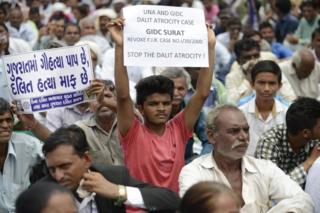Why are Dalits in Modi’s India angry?
Four years ago, a group of upper-caste men arrived at Mehul Vinodbhai Kabira’s modest two-room home in Gujarat and threatened to burn it down.
Bhayla is a nondescript village of around 450 low slung brick-and-cement homes straddling a highway dotted by pharmaceutical, engineering and bio-tech factories.
Most of the homes in this dense village are owned by land-owning upper castes, but around 70 belong to Dalits (formerly known as untouchables) like Mr Kabira, who form the lowest rung of India’s harsh caste hierarchy.
Mr Kabira’s crime? He dared to park his newly-bought auto-rickshaw for passengers near the village at the bus stop, which also doubled up as its three-wheeler stand.
His parents worked all their lives as scavengers, collecting manure, but their son had decided to shun the indignity of a lowly caste-based occupation. Instead, he took out a loan and started plying a three-wheeler.
“Most of the auto-rickshaws here are owned by upper-caste men. They couldn’t tolerate a Dalit plying his trade at the bus stand. So they beat me up and threatened me,” he says.
Mr Kabira did not take any chances. He left the village with his family to live with a relative some 15km (nine miles) away and drove his three-wheeler. When he returned to Bhayla in 2014, he sold off his auto-rickshaw, paid back his loan and signed up as a 217 rupees-a-day ($3; £2.40) contract worker in the “housekeeping” – a euphemism for a cleaning job – at a pharmaceutical factory.
‘Increased conflict’
A few houses away, Dayabhai Kanabhai Kabira, 42, faced the ire of upper-caste neighbours in a different way. A canny farmer, he had inherited two acres of farm land from his father, and sold it to buy a four-acre plot some 40km away to augment his income.
As his joint family grew, he built a second storey on his tiny plot to accommodate a growing joint family of a dozen people into four-and-a-half crowded rooms. His next door neighbour, an upper-caste farmer who lives in a shiny three-storey house, promptly built a 20ft (6m) high “caste” wall between the two homes.
“They built the wall so they didn’t have to see my face any longer,” says Mr Kabira.
Dalit lives have improved in Gujarat – and all over India – and many upper-caste people are finding it difficult to digest this. “Conflict increases where social conditions [for Dalits] may be getting slightly better,” says Pratap Bhanu Mehta of the Centre for Policy Research, a leading think-tank.
Traditional occupations
In the past, conflicts between Dalits and upper castes were restricted to fights over land, wages, water, housing and the practice of untouchability.
But earlier this month, things took a new, devious turn in Gujarat, one of India’s most prosperous states, ruled by Prime Minister Narendra Modi’s BJP for more than a decade.
A video surfaced showing four Dalit men being assaulted by zealous “cow protection” vigilantes. Their crime was that they were doing their caste job of skinning a dead animal. (Many Hindus consider cows sacred and the slaughter of the animal is banned in many Indian states. There have been attacks across India where Muslims have been accused of eating or smuggling beef.)
A night patrol with India’s cow protection vigilantes
Angry Dalits came out in protest and the parliament in Delhi was in uproar. Some 30 Dalits, including women, have tried to take their own lives – and one has died – since the incident.
On Sunday, tens of thousands of community members pledged to boycott some of their traditional tasks, including the disposal of dead animals and manual cleaning of sewers.
However, atrocities against Dalits are nothing new in Gujarat, the birthplace of former India leader Mahatma Gandhi, who waged a campaign against untouchability all his life.
But, as social scientist Ghanshyam Shah says, even Gandhi was helpless when schools in Gujarat set up by organisations owing allegiance to his ideals refused to admit Dalit students. The state saw some of the earliest upper-caste agitations against affirmative action for the Dalits in the 1980s.
Rising violence
Gujarat has only 2.3% of India’s 200 million Dalits – 14th most populous state for the community – yet it ranks high in terms of atrocities against them, with more than 1,000 cases of “crimes” against Dalits recorded in 2015.
Between 1990 and 2015, 536 Dalits were murdered in Gujarat and 750 Dalit women raped. The conviction rate is abysmal: suspects in 95 of 100 cases are freed, according to one study. Eleven districts remain officially declared as “atrocity prone” for Dalits since 1981.
“Dalits are protesting. They are asking questions, filing right to information applications, petitioning authorities and quizzing village council heads,” says Dalit rights activist Martin Macwan. “Upper castes are getting jittery and the violence continues.”
His organisation Navsarjan Trust carried out a four-year-long study – published in 2010 – recording 98 untouchability practices in nearly 1,600 villages in Gujarat.
Most of the findings were startling, for example:
But the recent violence against the Dalits, according to Mr Shah, is rooted in a shrill campaign by radical Hindu groups “telling people what to eat, drink, dress and monitor their behaviour”.
Critics say the self-styled “cow protection” vigilantes are running extortion rackets and running amok even as Prime Minister Modi maintains a curious silence.
The agitation in Gujarat may not hurt the BJP in polls much – a third of Dalit voters have voted for the Congress party in the recent past. But, as psephologist Sanjay Kumar says, it might hurt the party’s electoral prospects in Uttar Pradesh and Punjab, two states with large Dalit populations and which go to the polls early next year.
“It is a canary in the mine,” warns Mr Mehta. “There is deep social conflict bubbling from below.”
This cannot be good news for Mr Modi.
Source: Read Full Article



